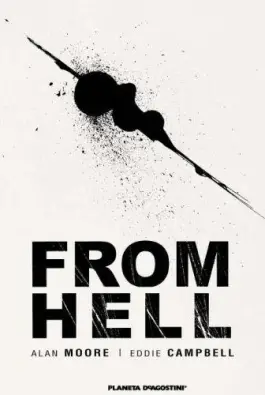
Original language: English
Original title: From Hell
Publication: starting in 1991, by chapters; 1999, as a complete work
Translation: Jaime Rodríguez, assisted by Beatriz Barba
Valuation: essential
In the very unlikely event (although, namely, that these Swedes, when they get down to it, are very crazy) that the Nobel Prize in literature is awarded to a creator of the world of comics, it seems to me that there is little doubt that one of the main candidates, if not the first, would be screenwriter Alan Moore, for many reasons, including the scripts for such notable graphic novels as Watchmen, V of Vendetta or the one that occupies today’s review, another magnum opus of this art (I no longer remember if it was the eighth or ninth.): From Hell, a recreation/elucidation of the figure and murders of the famous Jack the Ripper. As you see, friends, the Christmas spirit has not yet left ULAD…
I won’t beat around the bush for fear of destroying… sorry to spoil someone’s reading, since in the book the authorship of the crimes is revealed or attributed almost from the beginning and, in fact, a good part of the novel consists of accompany the murderer while he commits them. Following the hypothesis of the author Stephen Knight, who in 1976 published Jack the Ripper: The Final Solution, the Ripper would have been Sir William Gull, the first royal doctor and prominent Freemason, who would have killed his victims to cover up the scandal of a certain mistake committed by a young and crazy member of the royal house. For them, in the plot would be from Queen Victoria herself to prominent members of Scotland Yard, as well as simple agents, etc. Although they were quite successful at the time – a movie was even made based on the book, with Sherlock Holmes chasing the famous serial killer-, it seems that Knight’s theses have since been refuted and do not enjoy much credence today.

But that doesn’t matter much. Firstly, because Moore also, although he follows these ideas throughout the development of the novel, calls them into question, as well as the rest of the theories that have emerged about the identity of the ripper, in one of the two appendices, titled, significantly Dance of the gull catchers (that is, the dance of seagull catchers, but also of the fakers). And, on the other hand, because the interesting thing about his narrative is not so much whether the authorship must be attributed to this or that character, but rather the stark portrait he makes of a deranged, ambitious and megalomaniacal human soul… and of a society, that of the British Empire of the Victorian era, which corresponded point by point with that individual portrait. Because if something becomes evident in this graphic novel, it is that, crimes aside, the greatest horror of the London in which it takes place is the tremendous economic difference between them, the misery in which the inhabitants of Whitechapel live, where the crimes take place. murders, in contrast with the opulence of the good society of the West End, the self-complacency of the Freemasons, the hypocrisy of royalty… A world of inequalities where the most harmed are women and, above all, those who are forced to “take to the streets” to survive, like the murderer’s victims; What’s more, in the book Gull himself sees his actions as part of a war of men against women, in which those have managed to reverse the situation, after many millennia of domination by them… The Ripper’s crimes would not be for him but ritual sacrifices to establish the power of the heteropatriarchy, in the eternal struggle of the feminine and the masculine, of the Moon goddess against the Sun god… (not bad for some gentlemen from 30 years ago, eh, friends?). It must also be said that Gull – or the Gull that Alan Moore presents to us – was a little bit crazy with the esoteric-metaphysical stuff and, in fact, one of the most memorable chapters of the book is not at all gruesome, but a “psychogeographical” tour that he takes through London, following the trail of the churches of his admired Hawksmoor and other monuments, which is fascinating and also quite disturbing.

Opposite the murderer is Inspector Abberline, a representation not only of the honest but unimaginative policeman, but of the common man who has to face, with evident helplessness, the monster, but not only the one represented by the murderer, but also that of the human and social degradation that he sees around him, in those streets from which he tries to escape without success. Both Jack/Gull and Abberline are the two protagonists, without a doubt, of the narrative, although without forgetting the prostitutes who are victims of the Ripper, whom the authors treat with special deference and compassion, stopping enough in the lives of each of them, so as not to turn them into simple props of viscera and blood, as happens in so many crime novels or movies, even those based on real cases. At its side there is still room – there are almost 600 pages – to find prominent figures who roamed the London of the time: from members of the royal family, as I have already said, to the famous “elephant man”, John Merrick, Oscar Wilde , William Morris, the painters Whistler and Sickert – this one, involved in the matter, in fact -, etc. Everyone moves through a city recreated with every detail and knowledge, in contrast sought, in more than one vignette, with the sketching of human figures. London, without a doubt, is no longer the setting in this work, but one more of the characters and not the least important…
I have talked throughout the review about Moore because he is the author of a script of a complexity and depth that is rarely found in graphic novels, but I do not want to forget the magnificent graphic work of the Scotsman Eddie Campbell, who in an apparently sober style -contributing to that impression is not only the essential black and white (although, apparently, there is also a later colored edition that I have no intention of ever seeing, not even out of curiosity…), but the strict and almost invariable distribution of the vignettes on the page – nevertheless manages to convey all the horror and agitation inherent in such a tremendous story, with a style that we could call “contained expressionist”. The crime scenes themselves, based on the best cinematic editing, are simply terrifying. Just for the graphic aspect of this comic (although the term here, more than in any other work, is very short) the book would be worth it, but if we add Moore’s script, there is no doubt that we are faced with a great novel, both detective and horror, plus a first-rate psychological and sociological study and an absorbing narrative that make this work, definitely, essential.

Source: https://unlibroaldia.blogspot.com/2024/01/alan-moore-eddie-campbell-from-hell.html


